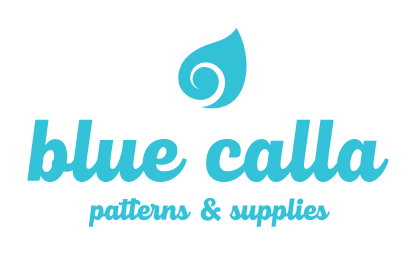
Aster Handbag Sew Along - Day 2
Share

Hi everyone! Welcome back! Are you ready for Day 2? Today we’re going to attach our exterior vinyl accent pieces and construct the exterior of our bag.
So first up, grab your front and back panel pieces and your 4 corner overlay pieces. Per the pattern use your double sided tape and place in the bottom corners of the panel piece. I still don’t have any tape so I’m using clips... I know, I’m a rebel like that.
We’re going to sew the curved part of the overlays with a 1/8” seam allowance. I like to increase my stitch length when I top stitch, so do that now if you like (I like to use the 3.5-4 setting), you’ll notice that I also use a walking foot. It’s my favourite thing- I don’t know what I did before I started using it-I’d be lost if I didn’t have it now. If you have one I highly suggest using it. Go ahead and attach all 4 overlays on your front and back panel pieces.
How do they look? Awesome! Next we’re going to attach our strap connectors. These can be intimidating but I promise, they look so great when you’re done. You can also use hardware strap attachments if you prefer – just refer to the pattern Celine walks us through attaching those!
I like to mark where my straps are going to go using the pattern, if you’re okay with using the measurements in the pattern – you can go ahead and do it that way. (And yes that’s loose leaf paper instead of copy paper, totally ghetto but sometimes you work with what you’ve got ha!)

So now we’re going to stitch down the folded sides of the connectors per the pattern instructions (step 14). Using your marks on your panel pieces as your guides, sew your strap connector in place. I like to use the same method we used on the bottom piece to hide the threads and tie off on the back of the panel so you can’t see where you start and stop with stitching. To make this a little easier, I like to start at the bottom of the connector – use what feels most comfortable to you. Repeat for the three remaining connectors.

Next up we’ll assemble our sides. You’ll notice in the pattern you can add faux piping to the sides if you like, I chose to omit that part but if you want to add it follow steps 23-24. I’m starting at step 25.
When clipping your exterior side panel bottom and exterior side top panel pieces together make sure you have the diamond shaped piece facing in the right direction. The point will be at the top of your assembled piece, after opening and top stitching. Sew those together with a 3/8” seam allowance, and top stitch along the bottom accent piece with the seam allowance towards the exterior side bottom piece.

Next up are our side connector pieces. Fold in the sides to the centre mark you made per the pattern directions. We’re going to sew around the pieces to hold those folded sides in. We’re then going to find the centres of the side panel pieces and mark those at the top and bottom. Take one of your connector pieces and slip the d-ring over one end and fold over at 1”. We’ll then use the centre lines we made on our exterior pieces to centre our connector pieces and attach with a 1/8” seam allowance. Do this for both sides.

This is the spot where I like to attach my handmade tag; I also like adding an accented backing to the tag, not for any particular function... I just like how it looks. I take a scrap piece of vinyl and trace my backing piece then add a ½” to all 4 sides-that gives me lots of wiggle room. I cut out the rectangle and then mark the middle of my panel and figure out placement from there. Sometimes I like it near the top, sometimes the bottom, sometimes the back, sometimes the front. It’s all good, if you’re adding one do what looks good to you. I follow the same steps for stitching on the accent piece that I do for the bottom and strap tabs, and pull my threads through and knot. Nice and neat!

Next mark where your slits will go for the tag, remember that less is more, and don’t cut your slits too big! Attach your tag and admire the pretty *wink*. Flip that piece over and grab a scrap piece of your fusible interfacing and iron it over the tag prongs. It’ll help keep the hard edges from rubbing things inside your purse.
Okay, your exterior pieces should be ready to go now, flip them over on the back sides and make a mark on the bottom of each 3/8” from each side. At least that’s how I do it, if I don’t mark it I’m going to forget and sew all the way to the bottom. Guaranteed. Every time.
Clip your bottom piece to a main panel, and sew – remembering to stop 3/8” from each side! Repeat for the second main panel, then each side piece. When complete your 4 exterior pieces will look like the image below.

Now to sew up the sides of the bag! It’s basically like assembling a box, we’re going to clip one body panel to a side panel making sure to line up the edge of your corner overlay with the top part of the side panel. Sew from the top edges down again leaving a 3/8” space at the bottom. I know it can seem like we’re going to have a hole in the corners at this point but we won’t, the three 3/8” spaces you’re leaving are matching up and will make a tight corner. I promise. Trim the excess seam allowance to 1/8”, being super careful not to cut through any of your previous stitches.

Are you ready? Time to turn that gorgeousness right side out. Look at that! You did so awesome. Are you ready for another tip? Usually at this point of my bag making adventure I’d iron the heck out of those seams so they’re nice and crisp but since vinyl and the iron are mortal enemies, I use a different approach. I roll the seams between my fingers a bit and use my clips to pull the seams tight. It’s not as great as the iron would be, but better than a big melty mess you’ll want to cry over ;)

After you’ve done admiring and clipping your seams, set that beauty aside, and we’re going to make the top panel pieces. Transfer your marks using the pattern piece as your guide. You’ll then clip your pieces together – a marked piece with an unmarked piece. Sew together and carefully trim down to 1/8” seam allowance. Once you have both pieces sewn and trimmed, turn them right side out; remember on the seams of the bag we rolled the seams between our fingers instead of ironing them? Go ahead and do that here too, it helps get everything sitting correctly.

You’re then going to take your peltex pieces and fit them inside, it can be tricky, just keep working it as close as you can in to the corners and top. Use your clips to hold the peltex in place and top stitch along the edges (Don’t forget about adjusting your stitch length!)

Now we’re going to install our magnets and our twist lock. Transfer your magnet marks to the top panels, make your slits through the vinyl and peltex being really careful not to go through both sides of the vinyl! I like to make sure that I have the male and female pieces of the snap both on the same side of top panels. Next install your twist lock according to your hardware instructions.

Last bit for today is basting on the top panels to your bag. Clip your top panels to your front and back panels, making sure that you have them facing the right way ;)
Final tip of the day, I like to take a piece of washi tape or something similar and cover my handmade label before proceeding, that way later on when top stitching the bag etc, I’m not getting little scratches on it where it’s been dragged on the surface of the table or whatever.

Do you love it? I bet it’s beautiful! Tomorrow is the final day of our sew along, we will be assembling the interior part of our back and completing the bag. Now go grab a drink, and relax, you earned it today! ;) See you tomorrow!




1 comment
Good morning! When I insert the peltex into the top panels I have found it works better to clip it on before turning the panels right-side-out. I lay down the panels, center the peltex, then clip it along the bottom edge. After turning the panels RS out, you can smooth it out and move your clips to the top and sides for sewing. It really makes things a lot easier for me :)